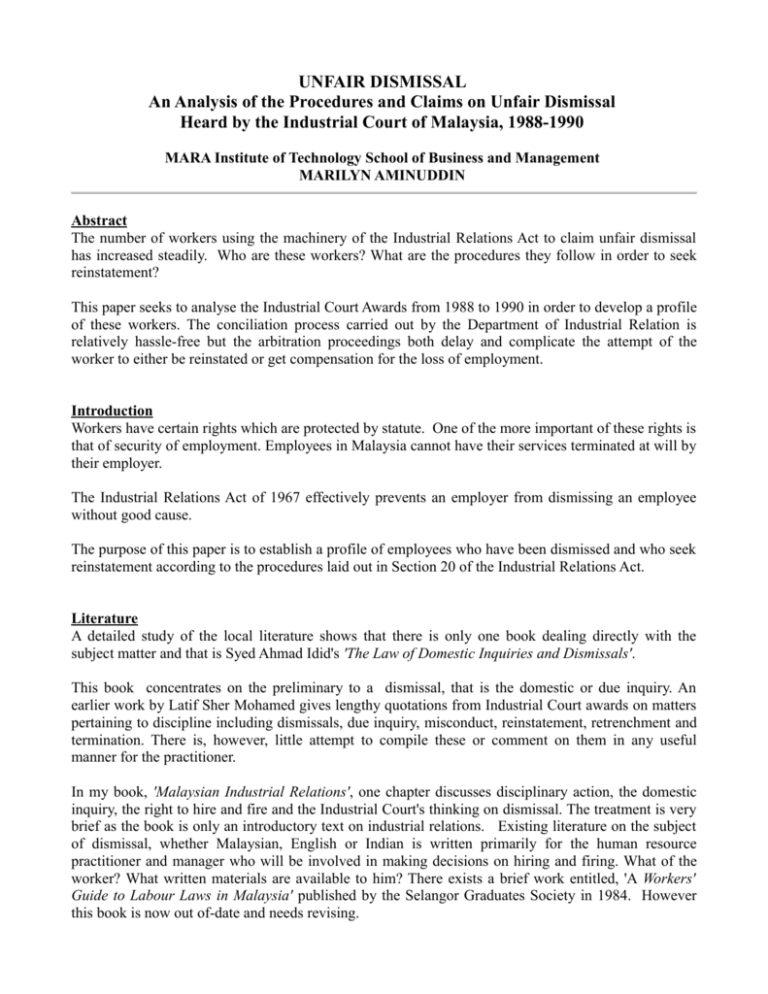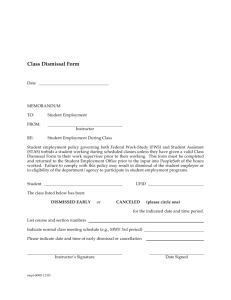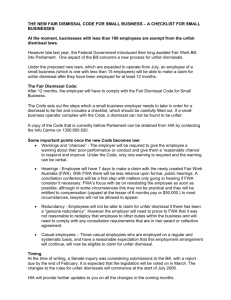UNFAIR DISMISSAL An Analysis of the Procedures
advertisement

UNFAIR DISMISSAL An Analysis of the Procedures and Claims on Unfair Dismissal Heard by the Industrial Court of Malaysia, 1988-1990 MARA Institute of Technology School of Business and Management MARILYN AMINUDDIN Abstract The number of workers using the machinery of the Industrial Relations Act to claim unfair dismissal has increased steadily. Who are these workers? What are the procedures they follow in order to seek reinstatement? This paper seeks to analyse the Industrial Court Awards from 1988 to 1990 in order to develop a profile of these workers. The conciliation process carried out by the Department of Industrial Relation is relatively hassle-free but the arbitration proceedings both delay and complicate the attempt of the worker to either be reinstated or get compensation for the loss of employment. Introduction Workers have certain rights which are protected by statute. One of the more important of these rights is that of security of employment. Employees in Malaysia cannot have their services terminated at will by their employer. The Industrial Relations Act of 1967 effectively prevents an employer from dismissing an employee without good cause. The purpose of this paper is to establish a profile of employees who have been dismissed and who seek reinstatement according to the procedures laid out in Section 20 of the Industrial Relations Act. Literature A detailed study of the local literature shows that there is only one book dealing directly with the subject matter and that is Syed Ahmad Idid's 'The Law of Domestic Inquiries and Dismissals'. This book concentrates on the preliminary to a dismissal, that is the domestic or due inquiry. An earlier work by Latif Sher Mohamed gives lengthy quotations from Industrial Court awards on matters pertaining to discipline including dismissals, due inquiry, misconduct, reinstatement, retrenchment and termination. There is, however, little attempt to compile these or comment on them in any useful manner for the practitioner. In my book, 'Malaysian Industrial Relations', one chapter discusses disciplinary action, the domestic inquiry, the right to hire and fire and the Industrial Court's thinking on dismissal. The treatment is very brief as the book is only an introductory text on industrial relations. Existing literature on the subject of dismissal, whether Malaysian, English or Indian is written primarily for the human resource practitioner and manager who will be involved in making decisions on hiring and firing. What of the worker? What written materials are available to him? There exists a brief work entitled, 'A Workers' Guide to Labour Laws in Malaysia' published by the Selangor Graduates Society in 1984. However this book is now out of-date and needs revising. The Procedures For Claiming Unfair Dismissal What does a worker do once his contract of service has been terminated? The relevant legislation covering this situation is the Industrial Relations Act of 1967 (amended 1989). Prior to the recent amendments, Section 20 of the Act allowed a non-unionised worker to file a complaint with the Department of Industrial Relations if he believed he had been unfairly dismissed. Within 30 days (now 60 days) of the dismissal the worker concerned had to write to the Department giving his name and address and request reinstatement. Section 18 (1) provided for a worker who was represented by a union to report a dispute to the same Department. Conciliation On receiving a complaint of unfair dismissal, the Department of Industrial Relations set in motion the wheels of the process of conciliation whereby the officers offer their help to try and settle the dispute between the worker and his employer. Conciliation should not be confused with arbitration. The conciliator can only use his experience, listening skills and persuasive abilities. He cannot force a settlement on the parties. If the conciliation procedures are not successful, the Minister of Human Resources (previously known as the Minister of Labour) is informed and he will decide whether or not to refer the case for arbitration by the Industrial Court. Table 1 shows that not all unresolved cases were referred to the Court. If the Minister decides not to refer a complaint to the Court the worker could apply to the High Court to quash the Ministerial decision. The conciliation service of the Department of Industrial Relations is very effective in settling complaints of unfair dismissal. Table 1 illustrates this. Alternative Machinery There is an alternative machinery available to the dismissed employer other than the procedure described above. He can take steps to sue the employer in the High Court either for breach of contract or wrongful dismissal. This route might be used by government servants who are not covered by the Industrial Relations Act, workers who fail to observe the 30 day time limit (now 60 days), and those who are not considered "workmen" under the Act. Arbitration Once a case is referred to the Industrial Court, the employer and the employee will be served with a notice informing them of the date for mention of the case. This notice also points out that if either of the parties wish to be represented by a legal practitioner, they are required to fill out the appropriate forms. Table 2 shows how employees have been represented at the Court in the three years of the study. In a large majority of the cases, even where the party at the Court is a union acting on behalf of one or more of its members, lawyers were involved in representing the worker. For non-unionised workers, the percentage of those using the services of a lawyer was even higher. In 1988, 72% of the non-unionised workers had a lawyer, in 1989 74% and in 1990 59%. In only 7% of cases on average did workers attempt to represent themselves. A close study shows that where the worker appeared before the Court personally, it was mostly to give details of a settlement made out of court. A number of reasons for the overwhelming presence of lawyers could be put forward. Firstly, the language of the Court in the three years under study was mostly English. The majority of workers would find it difficult to prepare their written submissions and present their case orally in English in the Court. Secondly, no matter how capable the average worker may be, the ability to clearly and cogently present a case in court, and cross-examine witnesses, many of whom will be managers, calls for skills beyond the reach of most. Thus the workers rely on lawyers to present their case. The Malaysian Trade Union Congress (MTUC) offers its services to workers at reasonable rates but the number of of officers available to present cases was very few in the years in question. The Court has a heavy agenda. The number of claims of unfair dismissal heard by the Industrial Court has increased significantly over the years. Table 3 shows the number of awards relating to dismissals handed down. Profile of workers Claiming Unfair Dismissal An analysis of the Industrial Court awards reveals certain information about those who claim unfair dismissal. It is possible to identify the employee's salary range, his level in the organizational hierarchy, his length of service and other useful data. The number of claimants of unfair dismissal is shown in Table 4. The total number of claimants exceed the number of cases heard because in many instances a group of workers are involved. This is especially true of cases relating to retrenchment, for example in Award No. 83/89, there were 19 claimants and in Award No. 255/89 there were 31 workers claiming reinstatement. Where the reason for dismissal is misconduct, it is more likely that only one or two workers will be involved although in Award No. 256/90, 58 workers were dismissed for refusing to do overtime. It appears that the workers' concerted boycott of overtime was a tactic to pressurize the employer during a dispute over the dismissal of a union leader. Interestingly, the Court found the penalty of dismissal in this situation "excessively harsh". The proportion of female claimants was far less than that of males. Over the three years only 22% of the claimants were female. It can only be surmised why this might be so. It could be that as females make up a smaller percentage of the total work force logically they would form a smaller group of those dismissed. It is also possible that women are less likely to commit misconduct. In the 1990 cases, the employer's alleged reasons given for the termination of 41 of the 83 cases where female claimants were involved is shown in Table 5. Clearly few women were dismissed for misconduct. Generally, women are more conformist and more accepting of organisational discipline.' It can be further conjectured that women are less aware of their rights or more timid and thus unwilling to "fight back" if faced with dismissal. It is unfortunate that it is not possible to estimate the percentage of the work force who are dismissed annually and the percentage who end up in the Industrial Court. This cannot be done because there exist no figures on the total number of workers terminated each year. There is no legal requirement for an employer to report dismissals to any authority and thus there is no way of knowing how many dismissals take place. Employers are requested to report retrenchments to the Ministry of Human Resources. In 1988 some 3,000 retrenchments were reported but the number of those retrenched fluctuates wildly depending on the economic situation. In the six month period of January-June 1987 there were 10,000 workers reported retrenched. The three year period 1988-1990 was a boom time for the economy and the number of retrenchments will have dropped considerably. Indeed the country is now facing a labour shortage. In such a situation it may be assumed that employers would be more reluctant to dismiss workers even when guilty of misconduct knowing that it will be difficult to replace them. What percentage of the work force bring claims to the Industrial Court? In 1988 the number of workers employed in the private sector was 5.2 million (Min. of Finance: 1988-1989). Public sector employees are excluded because this study deals only with those workers eligible to bring claims to the Industrial Court. Thus the 289 claimants whose cases were heard by the Court in 1988 represent a minuscule 0.0005%. What is known about the claimants other than their sex? Not all the "workmen" who claim unfair dismissal work at the lower levels of an organization. A significant number of the claimants can be categorised as managers. Evidence as to whether a claimant was a manager or not was gleaned from the stated job title and any description of his duties. Supervisors are included here as managers. However, senior executives with professional functions but apparently no subordinates reporting to them were not considered to be managers. Table 6 shows that the Court can by no means be described as the "working man 's court", if by workman is meant non-executive level workers. One quarter of the claimants were managers, a figure which would appear to be out of proportion to the number of managers in the country. Presumably managers are over-represented at the Court not because they are more likely to be dismissed but because they are more knowledgeable. They are aware of the procedures for making representations, are willing to use the system and have the financial resources to pay for legal assistance. Table 7 shows whether the claimants were unionised or not. Clearly most of the workmen claiming unfair dismissal were not union members. It can be speculated that employers may be more cautious when terminating the services of union members knowing full well that the worker will, as a matter of course, contact his union and request its help. What level of salary was earned by the claimants?3 Table 8 shows that a quarter of the claimants earned over $1,000 per month and interestingly, this tallies closely with the number of managers. However, there are cases of workers who are not managers yet earn more than $1,000 per month. It is not possible to categorically state that a large proportion of the claimants were in the lower-paid group given the fact that there is no data in at least half the cases. How long have the claimants been working with the company at the time their services were terminated? Again, in over fifty per cent of the cases no information is given. Nevertheless it can be seen from Table 9 that on the whole, the spread is fairly even, that is, there are very junior workers who were dismissed (those with less than three years' service) but there are also those who have been with the same employer more than nine years, some of them for most of their working life. In a labour market of relatively young workers, those retrenched or dismissed after the age of 35 will have some difficulty in finding alternative employment. The situation is perhaps worse for those who are retrenched and thus are out of a job through no fault of their own. It is frequently said that justice, to be effective should be speedy. This maxim undoubtedly applies in cases where workers have been dismissed. Where the worker is unable to find alternative employment quick justice is imperative especially as Malaysia has no welfare benefits for the unemployed. Put simply, those out of work have no income. The Industrial Relations Act lays down no time limit for the settling of disputes and claims of unfair dismissal but it does say in Section 30 (3): "The Court shall make its award without undue delay and where practicable within 30 days from the date of reference to it of the trade dispute or of a reference to it under Section 20 (3)." _ The intention of the legislators is very clear. Decisions of the Court should be as expeditious as possible. Does the system at present fulfil the requirement of speedy justice? The statistics are very clear. Table 10 shows that the worker can expect to wait at least seven months or more from the date his case is referred to the Court by the Minister of Human Resources to the first day of hearing. This time lapse is however by no means the end of the story. It is not uncommon for three years to pass from the actual date of dismissal till the award is handed down. In Award No.20 of 1990 the claimant was dismissed on 29 December 1987, his case was referred to the Court by the Minister on 24 August 1988, and the Court hearing was held on 7 February 1990. Interestingly this long waiting period could be considered an anticlimax for the worker in that particular case as, finally, a Consent Award was recorded at the hearing. In Award No. 86 of 1990 the worker was dismissed in September 1987, the date of reference was March 1988 and the first date of hearing was March 1989. The hearings stretched over 16 days and were only completed and an award handed down in February 1990. Comments and complaints about the delay in the process have long been heard. An examination of the process shows that delay can creep in at several points. The worker had 30 days in which to make representations to the Industrial Relations Department. Then the conciliation process will begin. This may become drawn out for two reasons. The work load of the conciliating officer is heavy and bound to increase. Although the number of cases reported to the Department has risen rapidly with the growth in the labour force and the brisk pace of industrialisation, the number of of officers has not increased.4 Further, as has been described above, as long as the Industrial Relations Officer believes there is a possibility of a settlement, he will continue to call meetings with the parties involved. The conciliation process takes place at two levels-regional office and headquarters. The Minister himself may contact the parties. Obviously therefore it can easily take three or four months to discover that settlement is impossible, have a report prepared and present the case to the Minister for a decision whether or not to refer to the Court. Once a case is referred to the Court, the hearing dates will be decided upon. This is the second part of the process that leads to serious delays. A date acceptable to three parties has to be agreed upon. The Court itself is supposed to have a President and a number of chairmen to hear cases. However, at various times, especially in 1989 and 1990 there were long periods when vacancies existed. Not only is the Court frequently short-staffed but the number of lawyers who deal with workers' cases is very few. Their court schedules are full and so cases get put off until the advocates are available. In which industries were the claimants employed?5 Table 11 shows that the workers claiming unfair dismissal came from a range of industries and organisations including a few from non-business organisations. Outcomes of Workers' Claims What were the outcomes of the workers' claims that their dismissals were unfair or without just cause? Table 12 reveals the results of the worker's attempts to get reinstatement. A consent award is where the parties have come to a settlement out of court and this agreement is presented to the Court either before the date of hearing, on the first day of hearing or at some point during the proceedings. In nearly all consent awards, which constitute one third the total number of cases each year, a sum of money is paid to the claimants in return for his agreement to withdraw his case. why do employers not settle at the conciliation stage? It can be assumed that many employers are confident that the worker's case has no merits and will not be referred to the Industrial Court by the Minister. They therefore prefer to "hang out" or "wait and see". If the case is referred however, they may be advised by their lawyer that they would actually save money and time by paying the worker a sum of money. By compensating the worker they will save legal costs and more importantly they will avoid spending long periods of time at the Court. Cases are struck off by the powers given to the Court under Section 29(a) which says: "The Court may, in relation to any dispute before it or in relation to any reference to it under Section 20 (3) a) order that any party be joined, substituted or struck off' Mostly cases are struck off because either the claimant informs the Court in advance that he is withdrawing or, more commonly, the claimant fails to present his statement in case and fails to turn up in Court or have a representative there to argue his case. Reinstatement was relatively unusual-it was awarded in only 5 % of the cases, Where the dismissal is held to be unfair or without good cause the Court is reluctant to award reinstatement. There are several reasons for this. Firstly, given the delays described above which means that the dismissal took place two or three years previously, the employer will in all likelihood have filled the vacancy caused by the dismissal and the worker involved will have found a new job. Disruption to both parties is undesirable. Furthermore, by reinstating the worker some industrial relations problems may follow. Compensation was awarded in over one quarter of the cases analysed. This is the preferred decision of the Court when it is held that the employee was unfairly dismissed. The relief in lieu of reinstatement usually granted takes two forms, viz, "back wages" and compensation. Back wages are calculated from the date of dismissal to the last day of hearing up to a maximum of 24 months. This component of the compensation package has received criticism from a number of quarters. One writer suggests that the Court has no jurisdiction to award backwages as according to the Employment Act 1955, "wages" is defined as "remuneration which is payable to an employee for work done in respect of his contract of service" (Gomez: 1988) . This critic says "One is paid wages for work done and not for work not done." The word backwages is really a misnomer. The monies paid out are a form of compensation. The compensation proper is usually calculated as one month's salary times the number of years service. On occasion the Court has deducted between 30 and 50% of the compensation awarded because it considered the employee to have been partially responsible for his dismissal. See Awards No. 241 of 1990 and 255 of 1990. The "others" category under outcomes of claims refers to a few odd cases where either the Court found it had no jurisdiction to hear the case including two cases where the worker was considered to have resigned, i.e. he was not dismissed. Causes of The Dismissals What were the alleged causes of the dismissal of the employees involved? It should be noted that on occasion the Court discovered during the proceedings that the alleged reason was not the real reason. For example, several times purported retrenchments were in fact disguised cases of victimisation. Table 13 clarifies the reasons for the dismissals as alleged by the employer. The reasons can be classified under the headings of redundancy, misconduct, inadequate performance and others. The "other" reasons for the dismissal include cases of termination simpliciter and constructive dismissal. There exist employers who still are not aware that termination simpliciter is not acceptable under the Industrial Relations Act. In case No. 84 of 1990 the company's Personnel and Administration Manager said, "the company can give contractual notice without giving any reason . . . the Claimant's termination was based solely on contract. The Claimant has not committed any misconduct." The Court's comment on this was, "the concept and practice of termination of a workman by contractual notice for no reason has been literally thrown overboard. The termination of dismissal must be for just cause or excuse." Constructive dismissal is a relatively new concept and refers to situations where the employer takes action which repudiates the contract of employment of the worker. Some interesting cases belong in this category as they illustrate the extent to which employers will sometimes go to get rid of a particular employee. Redundancy cases can be expected to increase or decrease depending on the economic situation. Nevertheless even in times of economic "boom", some businesses find they are overstaffed and need to retrench. The right of the employer to re-organise his business and to decide on the number of employees necessary at any point of time is a prerogative not questioned by the Court. However, the procedures followed by the employer are of significance and whether there is any evidence of mala fide is the concern of the Court. Misconduct and inadequate performance are the most common causes of dismissal. If employers have the right to terminate employees for redundancy, misconduct and inability to do work satisfactorily, what then causes employers to lose their cases at the Industrial Court? The final section of this paper will briefly examine the implications of Table 14 which looks at the causes of the termination and the outcomes. What mistakes are made by employers which led to their having to either reinstate or compensate the employees they had dismissed? Basically there were four (4) reasons why the Court found the claimants to be unfairly dismissed. Employers could not prove their cases, they failed to follow proper procedures, they acted apparently in ignorance of employee rights or purposely victimised workers especially as regards trade union activities. Lack of Proof Employers frequently were unable to prove their cases to the satisfaction of the Court. Where misconduct was alleged the employer often had insufficient or no documentation. Furthermore, witnesses were either lacking or unconvincing. The delay in hearing cases works to the detriment of the employer in this instance as some witnesses may have left the organization and be untraceable. Eighteen months to two years later, those who remain in the organization will find it difficult to tell their stories accurately. The same problem applies to cases of retrenchment. The employer was not always able to show that a particular position was no longer needed or that the company was facing serious financial problems. For example, in Award No. 74 of 1989 the Court said, "the employer cannot be allowed, under the cover of recession and reorganisation to rid himself of an employee so as to replace him with a lower paid new recruit, or to dismiss one for some offences committed in the past which did not justify dismissal at the time." In Award No.86 of 1990 a case was described for which the hearings spread over 16 days. The reason given for the dismissal was redundancy but the claimant was able to show that in fact her services were terminated because she was unwilling to accept a change in position from Legal Officer to Bank Officer. The Court found that though there was no change in salary, the transfer was a humiliating demotion for the claimant. The work previously done by the claimant still existed and was either still given to her or it was passed to outsiders. Improper Procedures In many instances employers lost their case because they followed inadequate procedures. Where the cause of dismissal was misconduct, the Court expected the employer to carry out a domestic inquiry run according to the principles of natural justice. Indeed, this requirement is mandatory for employees covered by the Employment Act. A great number of employers have tried to argue in the Court that an inquiry is not always necessary and while the Court has contradicted itself on occasions, the general thinking of the Court is that a fair hearing is an essential requirement for a workman to be properly dismissed. When employers pleaded redundancy as the cause of dismissal, their chief difficulty was in following the principle of Last in, First Out (LIFO) as recommended in the Code of Conduct for Industrial Harmony, a document prepared in 1975 which lays out ideal practices in the field of personnel management and industrial relations. Victimisation A number of cases stand out as examples of employers victimising workers for participating in legal activities of a trade union. For example, in Award No. 306 of 1988 the Court examined the issue of fixed term contracts. Some 35 teachers of a private school did not have their contracts renewed because they were actively involved in trade union activities. The Court found that "the intention of the school was to rid itself of the union. The school's attitude and action blatantly fly in the face of the law and the Government's policy of the freedom of workers to form trade unions." Fortunately, such cases are rare. Conclusion This analysis of recent Court Awards reveals that claimants are mostly male, non- unionised, lower level workers whose monthly wages range from a few hundred dollars to four or five thousand. Their length of service also varies widely from less than a year to 15 years or more. The most common reason given for the dismissals was misconduct. To what extent is the procedure of conciliation and arbitration readily accessible and understandable to the worker? Conciliation poses no special problems to the dismissed employee, and the officers of the Department of Industrial Relations are ever available to advise. Indeed many employers perceive the officers to be sympathetic to the worker's side. 6 Should the case go to arbitration however, the process of decision-making is protracted and sufficiently complicated to require expensive legal assistance. REFERENCES 1) Aminuddin, M., (1990) Malaysian Industrial Relations, Singapore:McGraw-Hill. 2) Carrell M. R. and C.Heavrln, (1988) Collective Bargaining and Labour Relations,Columbus, Ohio:Merill. 3) Fulmer, W.E. and A.l.V. Casey, (1990) Employment at Will: Options for Managers Academy of Management 4 No. 2, 102-107. 4) Gomez. A.B. (1988) "Industrial Court's Relief in Respect of Unjustified Dismissals Berita Personnel, April, 1988. 5) Knell, A. (1989) Employment Law for the Small Business, London: Kogan Page. Latif Sher Mohamed, (1982) Discipline Without Punishment Kuala Lumpur SMPD Mgt. 6) Ministry of Finance (1988-1989) Economic Report Kuala Lumpur 7) Rathus, S.A. and J. Nevid, (1989) Psychology and the Challenges of Life, Orlando, Fl.: Holt. Robbins, S. (1982) Personnel, Englewood, NJ: Prentice-Hall. 8) Selangor Graduates Society (1984) A Workers' Guide to the Labour Laws, Kuala Lumpur, n/p. 9) Syed Ahmad Idid, (1988) The Law of Domestic Inquiries and Dismissals, Kuala Lumpur Pelanduk. Back to MMR Listing by Year Homepage




